Acoustic Recording Applications in Biological Surveys of Bats
VerifiedAdded on 2023/01/11
|7
|1771
|61
Report
AI Summary
This report comprehensively examines the application of acoustic recordings in biological surveys of bats. It delves into the physics of sound and the evolution of acoustic instruments, highlighting their role in understanding animal species, particularly bats. The report discusses the use of Ecological Acoustic Recorders (EAR) and Automated Remote Biodiversity Monitoring Networks (ARBIMON) in remote habitat monitoring, emphasizing their efficiency and cost-effectiveness compared to traditional methods. Passive Acoustic Monitoring (PAM) is presented as a key technique, along with the use of specialized instruments like the Song meter-4 (SM4) for recording and analyzing bat echolocation calls. The report also touches upon the importance of acoustic research in species translocation, behavior studies, and the overall conservation efforts of endangered species. Various references support the concepts discussed, providing a detailed understanding of acoustic technology in bat research.

RUNNING HEAD: USE OF ACOUSTIC RECORDINGSIN BIOLOGICAL SURVEYS OF BATS
Use of acoustic recordings in biological surveys of bats
Name
Course
Institution
Date
Use of acoustic recordings in biological surveys of bats
Name
Course
Institution
Date
Secure Best Marks with AI Grader
Need help grading? Try our AI Grader for instant feedback on your assignments.
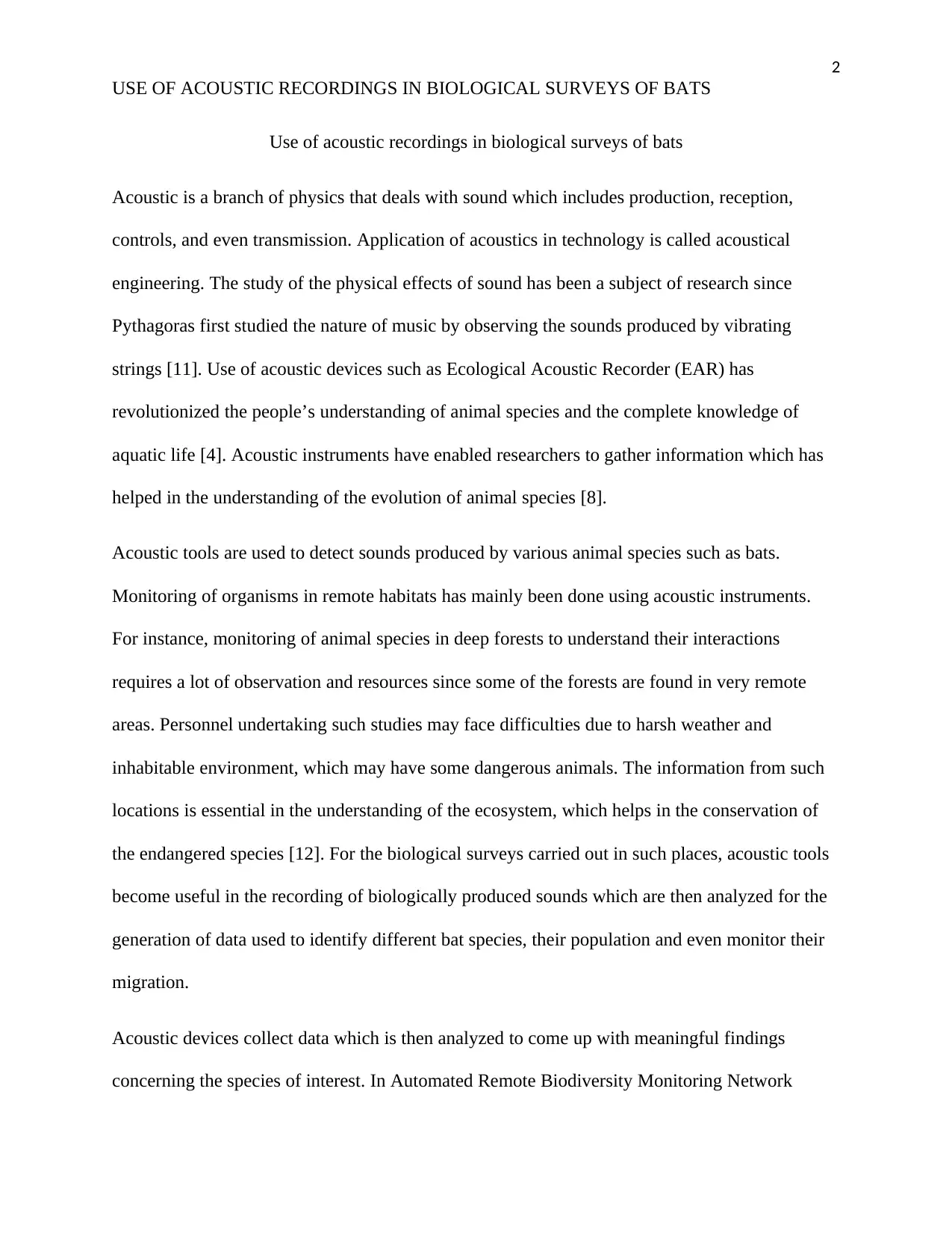
2
USE OF ACOUSTIC RECORDINGS IN BIOLOGICAL SURVEYS OF BATS
Use of acoustic recordings in biological surveys of bats
Acoustic is a branch of physics that deals with sound which includes production, reception,
controls, and even transmission. Application of acoustics in technology is called acoustical
engineering. The study of the physical effects of sound has been a subject of research since
Pythagoras first studied the nature of music by observing the sounds produced by vibrating
strings [11]. Use of acoustic devices such as Ecological Acoustic Recorder (EAR) has
revolutionized the people’s understanding of animal species and the complete knowledge of
aquatic life [4]. Acoustic instruments have enabled researchers to gather information which has
helped in the understanding of the evolution of animal species [8].
Acoustic tools are used to detect sounds produced by various animal species such as bats.
Monitoring of organisms in remote habitats has mainly been done using acoustic instruments.
For instance, monitoring of animal species in deep forests to understand their interactions
requires a lot of observation and resources since some of the forests are found in very remote
areas. Personnel undertaking such studies may face difficulties due to harsh weather and
inhabitable environment, which may have some dangerous animals. The information from such
locations is essential in the understanding of the ecosystem, which helps in the conservation of
the endangered species [12]. For the biological surveys carried out in such places, acoustic tools
become useful in the recording of biologically produced sounds which are then analyzed for the
generation of data used to identify different bat species, their population and even monitor their
migration.
Acoustic devices collect data which is then analyzed to come up with meaningful findings
concerning the species of interest. In Automated Remote Biodiversity Monitoring Network
USE OF ACOUSTIC RECORDINGS IN BIOLOGICAL SURVEYS OF BATS
Use of acoustic recordings in biological surveys of bats
Acoustic is a branch of physics that deals with sound which includes production, reception,
controls, and even transmission. Application of acoustics in technology is called acoustical
engineering. The study of the physical effects of sound has been a subject of research since
Pythagoras first studied the nature of music by observing the sounds produced by vibrating
strings [11]. Use of acoustic devices such as Ecological Acoustic Recorder (EAR) has
revolutionized the people’s understanding of animal species and the complete knowledge of
aquatic life [4]. Acoustic instruments have enabled researchers to gather information which has
helped in the understanding of the evolution of animal species [8].
Acoustic tools are used to detect sounds produced by various animal species such as bats.
Monitoring of organisms in remote habitats has mainly been done using acoustic instruments.
For instance, monitoring of animal species in deep forests to understand their interactions
requires a lot of observation and resources since some of the forests are found in very remote
areas. Personnel undertaking such studies may face difficulties due to harsh weather and
inhabitable environment, which may have some dangerous animals. The information from such
locations is essential in the understanding of the ecosystem, which helps in the conservation of
the endangered species [12]. For the biological surveys carried out in such places, acoustic tools
become useful in the recording of biologically produced sounds which are then analyzed for the
generation of data used to identify different bat species, their population and even monitor their
migration.
Acoustic devices collect data which is then analyzed to come up with meaningful findings
concerning the species of interest. In Automated Remote Biodiversity Monitoring Network
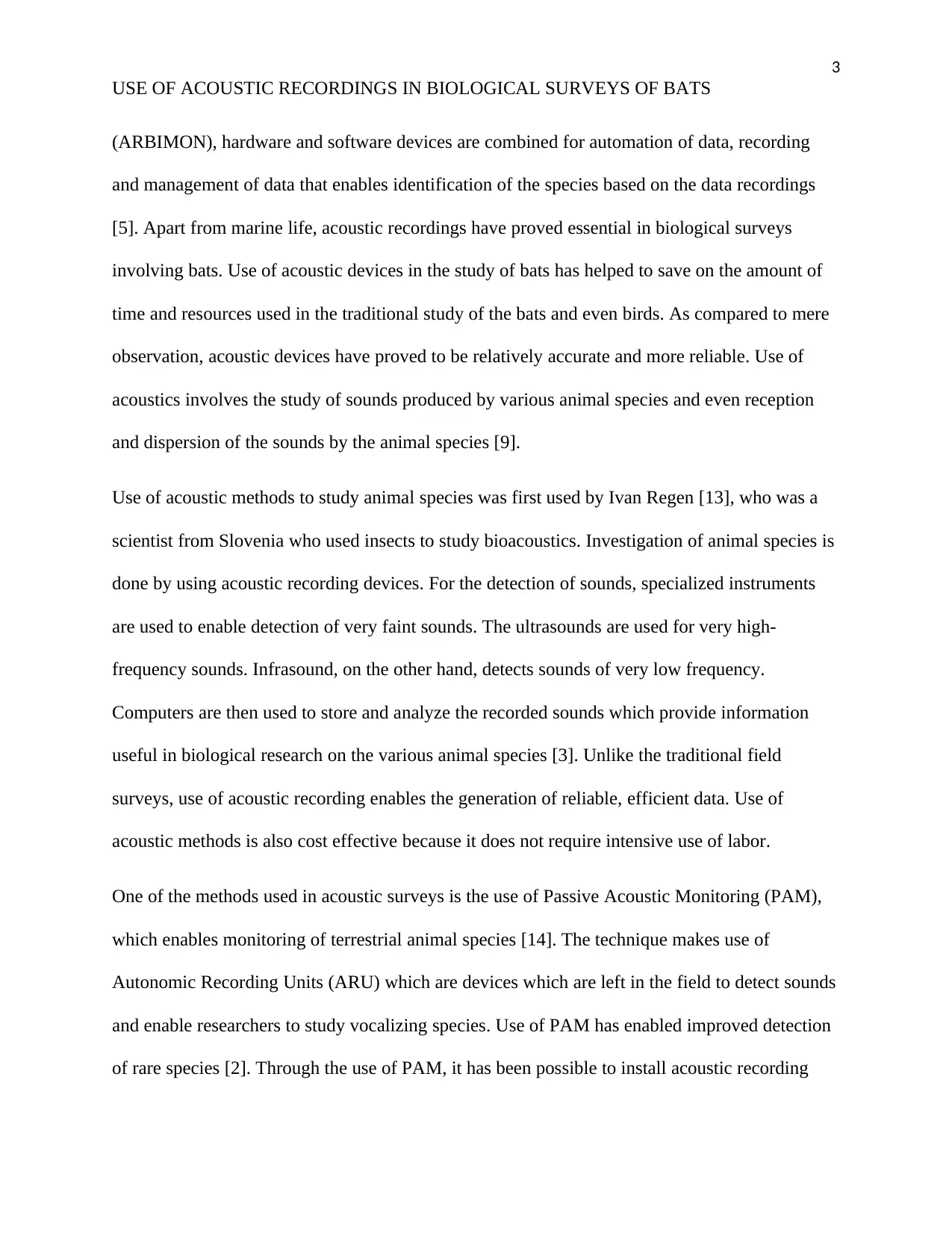
3
USE OF ACOUSTIC RECORDINGS IN BIOLOGICAL SURVEYS OF BATS
(ARBIMON), hardware and software devices are combined for automation of data, recording
and management of data that enables identification of the species based on the data recordings
[5]. Apart from marine life, acoustic recordings have proved essential in biological surveys
involving bats. Use of acoustic devices in the study of bats has helped to save on the amount of
time and resources used in the traditional study of the bats and even birds. As compared to mere
observation, acoustic devices have proved to be relatively accurate and more reliable. Use of
acoustics involves the study of sounds produced by various animal species and even reception
and dispersion of the sounds by the animal species [9].
Use of acoustic methods to study animal species was first used by Ivan Regen [13], who was a
scientist from Slovenia who used insects to study bioacoustics. Investigation of animal species is
done by using acoustic recording devices. For the detection of sounds, specialized instruments
are used to enable detection of very faint sounds. The ultrasounds are used for very high-
frequency sounds. Infrasound, on the other hand, detects sounds of very low frequency.
Computers are then used to store and analyze the recorded sounds which provide information
useful in biological research on the various animal species [3]. Unlike the traditional field
surveys, use of acoustic recording enables the generation of reliable, efficient data. Use of
acoustic methods is also cost effective because it does not require intensive use of labor.
One of the methods used in acoustic surveys is the use of Passive Acoustic Monitoring (PAM),
which enables monitoring of terrestrial animal species [14]. The technique makes use of
Autonomic Recording Units (ARU) which are devices which are left in the field to detect sounds
and enable researchers to study vocalizing species. Use of PAM has enabled improved detection
of rare species [2]. Through the use of PAM, it has been possible to install acoustic recording
USE OF ACOUSTIC RECORDINGS IN BIOLOGICAL SURVEYS OF BATS
(ARBIMON), hardware and software devices are combined for automation of data, recording
and management of data that enables identification of the species based on the data recordings
[5]. Apart from marine life, acoustic recordings have proved essential in biological surveys
involving bats. Use of acoustic devices in the study of bats has helped to save on the amount of
time and resources used in the traditional study of the bats and even birds. As compared to mere
observation, acoustic devices have proved to be relatively accurate and more reliable. Use of
acoustics involves the study of sounds produced by various animal species and even reception
and dispersion of the sounds by the animal species [9].
Use of acoustic methods to study animal species was first used by Ivan Regen [13], who was a
scientist from Slovenia who used insects to study bioacoustics. Investigation of animal species is
done by using acoustic recording devices. For the detection of sounds, specialized instruments
are used to enable detection of very faint sounds. The ultrasounds are used for very high-
frequency sounds. Infrasound, on the other hand, detects sounds of very low frequency.
Computers are then used to store and analyze the recorded sounds which provide information
useful in biological research on the various animal species [3]. Unlike the traditional field
surveys, use of acoustic recording enables the generation of reliable, efficient data. Use of
acoustic methods is also cost effective because it does not require intensive use of labor.
One of the methods used in acoustic surveys is the use of Passive Acoustic Monitoring (PAM),
which enables monitoring of terrestrial animal species [14]. The technique makes use of
Autonomic Recording Units (ARU) which are devices which are left in the field to detect sounds
and enable researchers to study vocalizing species. Use of PAM has enabled improved detection
of rare species [2]. Through the use of PAM, it has been possible to install acoustic recording
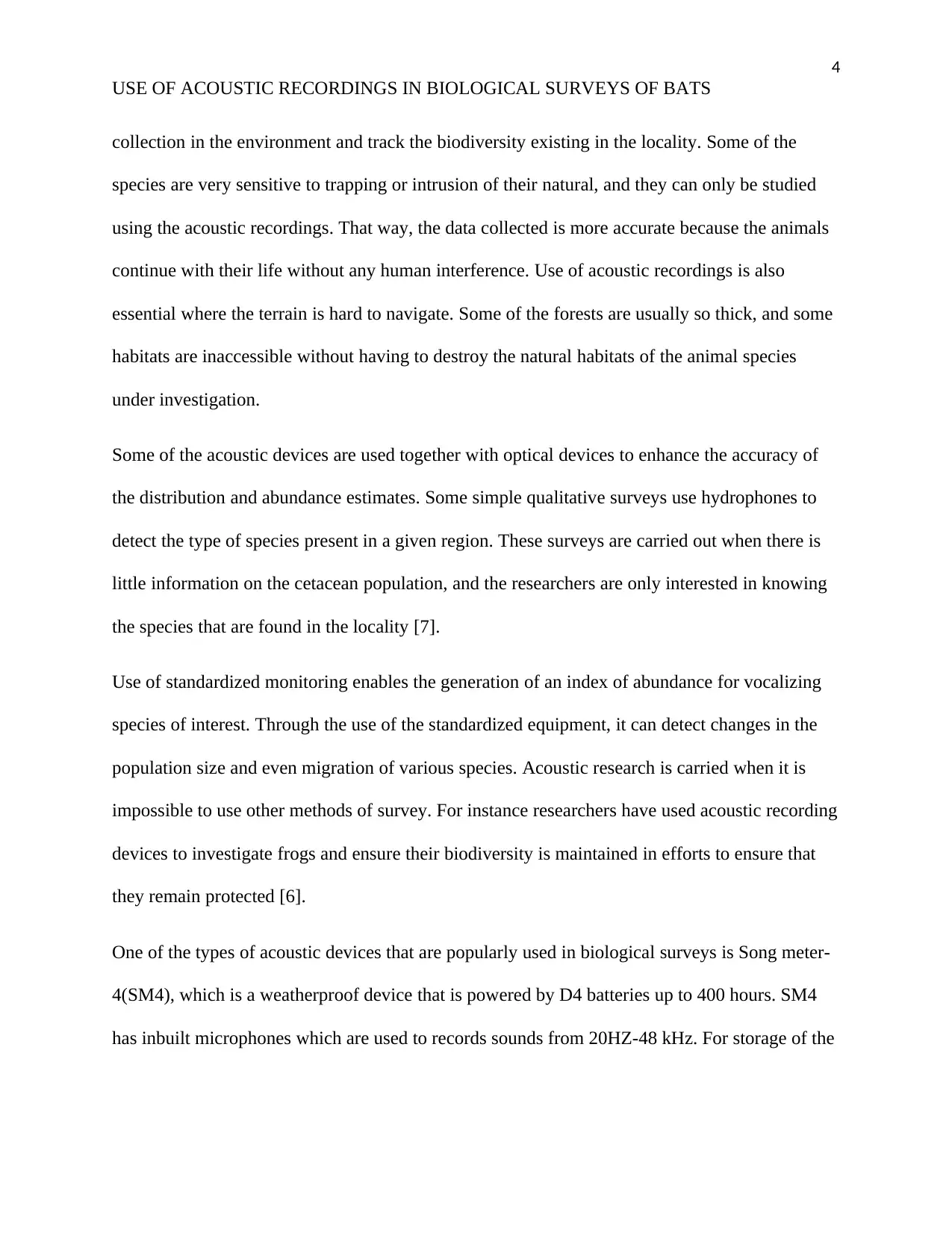
4
USE OF ACOUSTIC RECORDINGS IN BIOLOGICAL SURVEYS OF BATS
collection in the environment and track the biodiversity existing in the locality. Some of the
species are very sensitive to trapping or intrusion of their natural, and they can only be studied
using the acoustic recordings. That way, the data collected is more accurate because the animals
continue with their life without any human interference. Use of acoustic recordings is also
essential where the terrain is hard to navigate. Some of the forests are usually so thick, and some
habitats are inaccessible without having to destroy the natural habitats of the animal species
under investigation.
Some of the acoustic devices are used together with optical devices to enhance the accuracy of
the distribution and abundance estimates. Some simple qualitative surveys use hydrophones to
detect the type of species present in a given region. These surveys are carried out when there is
little information on the cetacean population, and the researchers are only interested in knowing
the species that are found in the locality [7].
Use of standardized monitoring enables the generation of an index of abundance for vocalizing
species of interest. Through the use of the standardized equipment, it can detect changes in the
population size and even migration of various species. Acoustic research is carried when it is
impossible to use other methods of survey. For instance researchers have used acoustic recording
devices to investigate frogs and ensure their biodiversity is maintained in efforts to ensure that
they remain protected [6].
One of the types of acoustic devices that are popularly used in biological surveys is Song meter-
4(SM4), which is a weatherproof device that is powered by D4 batteries up to 400 hours. SM4
has inbuilt microphones which are used to records sounds from 20HZ-48 kHz. For storage of the
USE OF ACOUSTIC RECORDINGS IN BIOLOGICAL SURVEYS OF BATS
collection in the environment and track the biodiversity existing in the locality. Some of the
species are very sensitive to trapping or intrusion of their natural, and they can only be studied
using the acoustic recordings. That way, the data collected is more accurate because the animals
continue with their life without any human interference. Use of acoustic recordings is also
essential where the terrain is hard to navigate. Some of the forests are usually so thick, and some
habitats are inaccessible without having to destroy the natural habitats of the animal species
under investigation.
Some of the acoustic devices are used together with optical devices to enhance the accuracy of
the distribution and abundance estimates. Some simple qualitative surveys use hydrophones to
detect the type of species present in a given region. These surveys are carried out when there is
little information on the cetacean population, and the researchers are only interested in knowing
the species that are found in the locality [7].
Use of standardized monitoring enables the generation of an index of abundance for vocalizing
species of interest. Through the use of the standardized equipment, it can detect changes in the
population size and even migration of various species. Acoustic research is carried when it is
impossible to use other methods of survey. For instance researchers have used acoustic recording
devices to investigate frogs and ensure their biodiversity is maintained in efforts to ensure that
they remain protected [6].
One of the types of acoustic devices that are popularly used in biological surveys is Song meter-
4(SM4), which is a weatherproof device that is powered by D4 batteries up to 400 hours. SM4
has inbuilt microphones which are used to records sounds from 20HZ-48 kHz. For storage of the
Secure Best Marks with AI Grader
Need help grading? Try our AI Grader for instant feedback on your assignments.
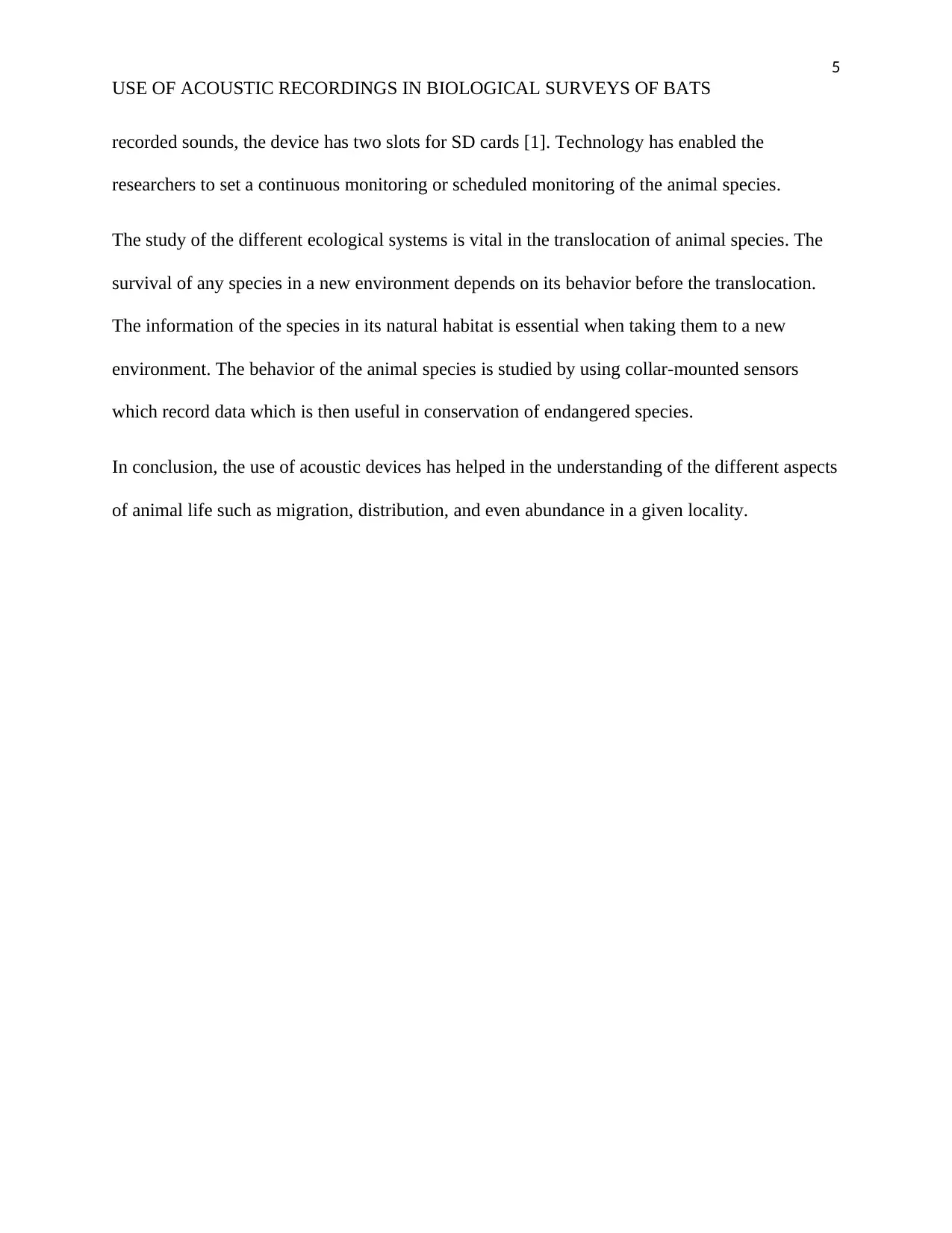
5
USE OF ACOUSTIC RECORDINGS IN BIOLOGICAL SURVEYS OF BATS
recorded sounds, the device has two slots for SD cards [1]. Technology has enabled the
researchers to set a continuous monitoring or scheduled monitoring of the animal species.
The study of the different ecological systems is vital in the translocation of animal species. The
survival of any species in a new environment depends on its behavior before the translocation.
The information of the species in its natural habitat is essential when taking them to a new
environment. The behavior of the animal species is studied by using collar-mounted sensors
which record data which is then useful in conservation of endangered species.
In conclusion, the use of acoustic devices has helped in the understanding of the different aspects
of animal life such as migration, distribution, and even abundance in a given locality.
USE OF ACOUSTIC RECORDINGS IN BIOLOGICAL SURVEYS OF BATS
recorded sounds, the device has two slots for SD cards [1]. Technology has enabled the
researchers to set a continuous monitoring or scheduled monitoring of the animal species.
The study of the different ecological systems is vital in the translocation of animal species. The
survival of any species in a new environment depends on its behavior before the translocation.
The information of the species in its natural habitat is essential when taking them to a new
environment. The behavior of the animal species is studied by using collar-mounted sensors
which record data which is then useful in conservation of endangered species.
In conclusion, the use of acoustic devices has helped in the understanding of the different aspects
of animal life such as migration, distribution, and even abundance in a given locality.
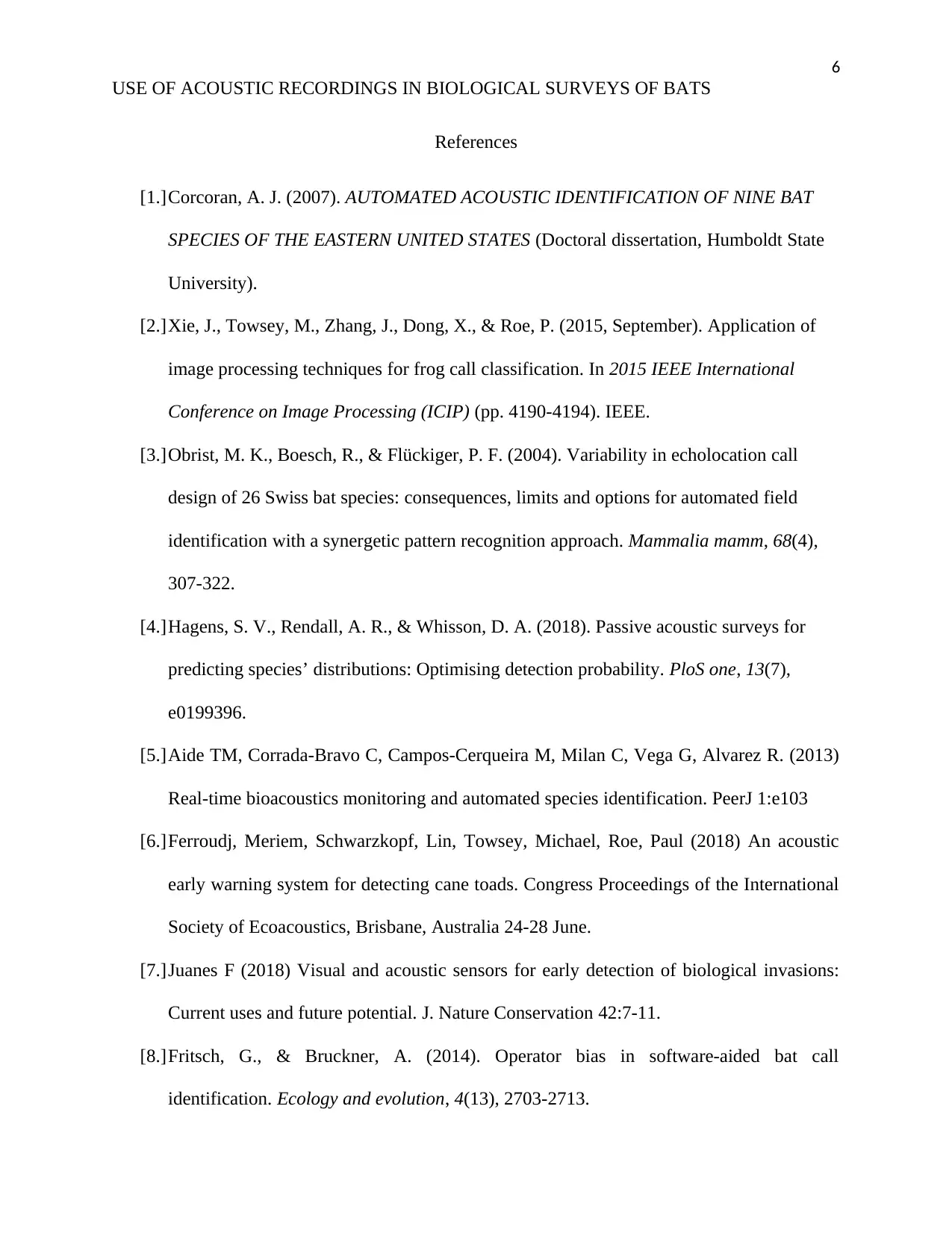
6
USE OF ACOUSTIC RECORDINGS IN BIOLOGICAL SURVEYS OF BATS
References
[1.]Corcoran, A. J. (2007). AUTOMATED ACOUSTIC IDENTIFICATION OF NINE BAT
SPECIES OF THE EASTERN UNITED STATES (Doctoral dissertation, Humboldt State
University).
[2.]Xie, J., Towsey, M., Zhang, J., Dong, X., & Roe, P. (2015, September). Application of
image processing techniques for frog call classification. In 2015 IEEE International
Conference on Image Processing (ICIP) (pp. 4190-4194). IEEE.
[3.]Obrist, M. K., Boesch, R., & Flückiger, P. F. (2004). Variability in echolocation call
design of 26 Swiss bat species: consequences, limits and options for automated field
identification with a synergetic pattern recognition approach. Mammalia mamm, 68(4),
307-322.
[4.]Hagens, S. V., Rendall, A. R., & Whisson, D. A. (2018). Passive acoustic surveys for
predicting species’ distributions: Optimising detection probability. PloS one, 13(7),
e0199396.
[5.]Aide TM, Corrada-Bravo C, Campos-Cerqueira M, Milan C, Vega G, Alvarez R. (2013)
Real-time bioacoustics monitoring and automated species identification. PeerJ 1:e103
[6.]Ferroudj, Meriem, Schwarzkopf, Lin, Towsey, Michael, Roe, Paul (2018) An acoustic
early warning system for detecting cane toads. Congress Proceedings of the International
Society of Ecoacoustics, Brisbane, Australia 24-28 June.
[7.]Juanes F (2018) Visual and acoustic sensors for early detection of biological invasions:
Current uses and future potential. J. Nature Conservation 42:7-11.
[8.]Fritsch, G., & Bruckner, A. (2014). Operator bias in software‐aided bat call
identification. Ecology and evolution, 4(13), 2703-2713.
USE OF ACOUSTIC RECORDINGS IN BIOLOGICAL SURVEYS OF BATS
References
[1.]Corcoran, A. J. (2007). AUTOMATED ACOUSTIC IDENTIFICATION OF NINE BAT
SPECIES OF THE EASTERN UNITED STATES (Doctoral dissertation, Humboldt State
University).
[2.]Xie, J., Towsey, M., Zhang, J., Dong, X., & Roe, P. (2015, September). Application of
image processing techniques for frog call classification. In 2015 IEEE International
Conference on Image Processing (ICIP) (pp. 4190-4194). IEEE.
[3.]Obrist, M. K., Boesch, R., & Flückiger, P. F. (2004). Variability in echolocation call
design of 26 Swiss bat species: consequences, limits and options for automated field
identification with a synergetic pattern recognition approach. Mammalia mamm, 68(4),
307-322.
[4.]Hagens, S. V., Rendall, A. R., & Whisson, D. A. (2018). Passive acoustic surveys for
predicting species’ distributions: Optimising detection probability. PloS one, 13(7),
e0199396.
[5.]Aide TM, Corrada-Bravo C, Campos-Cerqueira M, Milan C, Vega G, Alvarez R. (2013)
Real-time bioacoustics monitoring and automated species identification. PeerJ 1:e103
[6.]Ferroudj, Meriem, Schwarzkopf, Lin, Towsey, Michael, Roe, Paul (2018) An acoustic
early warning system for detecting cane toads. Congress Proceedings of the International
Society of Ecoacoustics, Brisbane, Australia 24-28 June.
[7.]Juanes F (2018) Visual and acoustic sensors for early detection of biological invasions:
Current uses and future potential. J. Nature Conservation 42:7-11.
[8.]Fritsch, G., & Bruckner, A. (2014). Operator bias in software‐aided bat call
identification. Ecology and evolution, 4(13), 2703-2713.
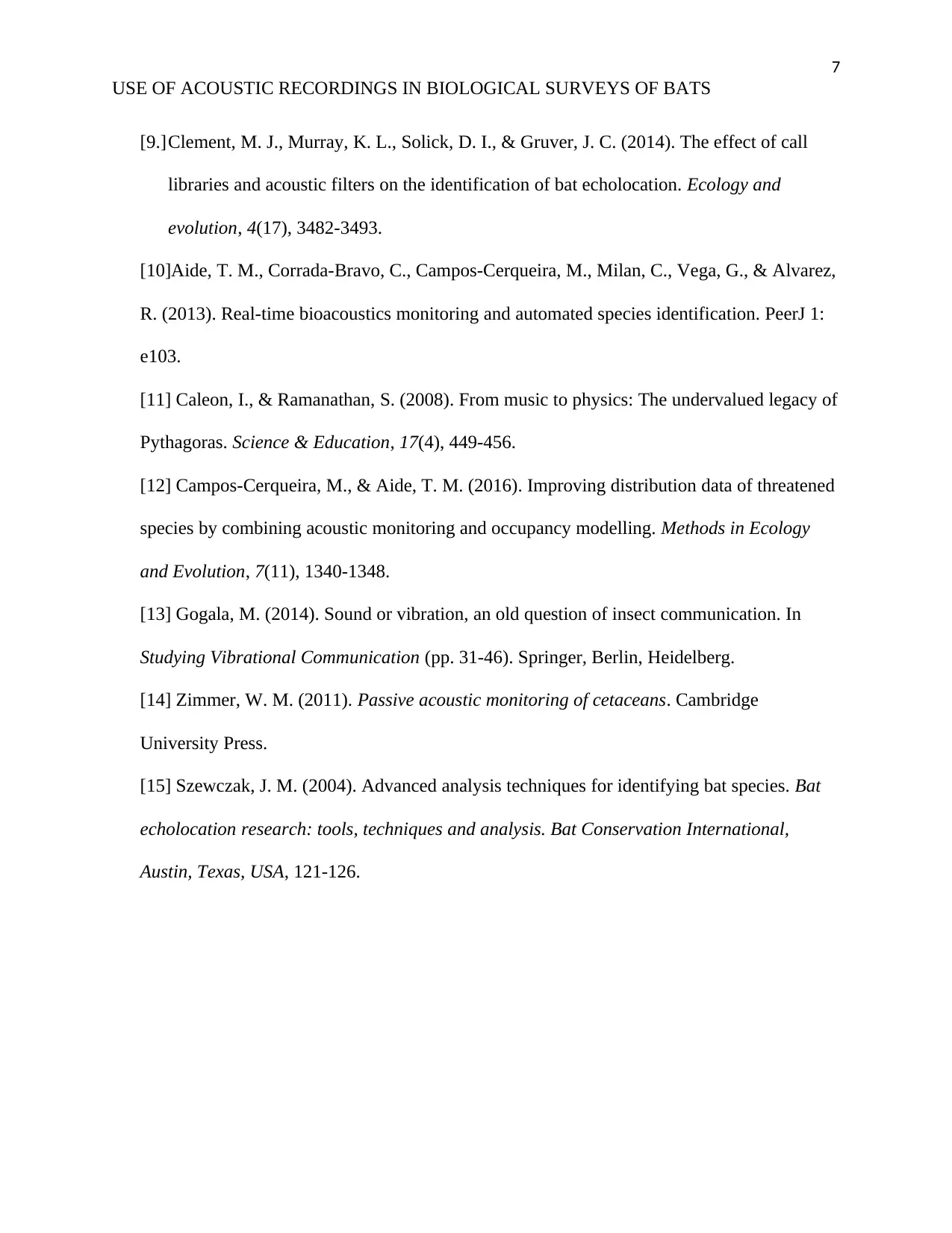
7
USE OF ACOUSTIC RECORDINGS IN BIOLOGICAL SURVEYS OF BATS
[9.]Clement, M. J., Murray, K. L., Solick, D. I., & Gruver, J. C. (2014). The effect of call
libraries and acoustic filters on the identification of bat echolocation. Ecology and
evolution, 4(17), 3482-3493.
[10]Aide, T. M., Corrada-Bravo, C., Campos-Cerqueira, M., Milan, C., Vega, G., & Alvarez,
R. (2013). Real-time bioacoustics monitoring and automated species identification. PeerJ 1:
e103.
[11] Caleon, I., & Ramanathan, S. (2008). From music to physics: The undervalued legacy of
Pythagoras. Science & Education, 17(4), 449-456.
[12] Campos‐Cerqueira, M., & Aide, T. M. (2016). Improving distribution data of threatened
species by combining acoustic monitoring and occupancy modelling. Methods in Ecology
and Evolution, 7(11), 1340-1348.
[13] Gogala, M. (2014). Sound or vibration, an old question of insect communication. In
Studying Vibrational Communication (pp. 31-46). Springer, Berlin, Heidelberg.
[14] Zimmer, W. M. (2011). Passive acoustic monitoring of cetaceans. Cambridge
University Press.
[15] Szewczak, J. M. (2004). Advanced analysis techniques for identifying bat species. Bat
echolocation research: tools, techniques and analysis. Bat Conservation International,
Austin, Texas, USA, 121-126.
USE OF ACOUSTIC RECORDINGS IN BIOLOGICAL SURVEYS OF BATS
[9.]Clement, M. J., Murray, K. L., Solick, D. I., & Gruver, J. C. (2014). The effect of call
libraries and acoustic filters on the identification of bat echolocation. Ecology and
evolution, 4(17), 3482-3493.
[10]Aide, T. M., Corrada-Bravo, C., Campos-Cerqueira, M., Milan, C., Vega, G., & Alvarez,
R. (2013). Real-time bioacoustics monitoring and automated species identification. PeerJ 1:
e103.
[11] Caleon, I., & Ramanathan, S. (2008). From music to physics: The undervalued legacy of
Pythagoras. Science & Education, 17(4), 449-456.
[12] Campos‐Cerqueira, M., & Aide, T. M. (2016). Improving distribution data of threatened
species by combining acoustic monitoring and occupancy modelling. Methods in Ecology
and Evolution, 7(11), 1340-1348.
[13] Gogala, M. (2014). Sound or vibration, an old question of insect communication. In
Studying Vibrational Communication (pp. 31-46). Springer, Berlin, Heidelberg.
[14] Zimmer, W. M. (2011). Passive acoustic monitoring of cetaceans. Cambridge
University Press.
[15] Szewczak, J. M. (2004). Advanced analysis techniques for identifying bat species. Bat
echolocation research: tools, techniques and analysis. Bat Conservation International,
Austin, Texas, USA, 121-126.
1 out of 7
Your All-in-One AI-Powered Toolkit for Academic Success.
+13062052269
info@desklib.com
Available 24*7 on WhatsApp / Email
![[object Object]](/_next/static/media/star-bottom.7253800d.svg)
Unlock your academic potential
© 2024 | Zucol Services PVT LTD | All rights reserved.
